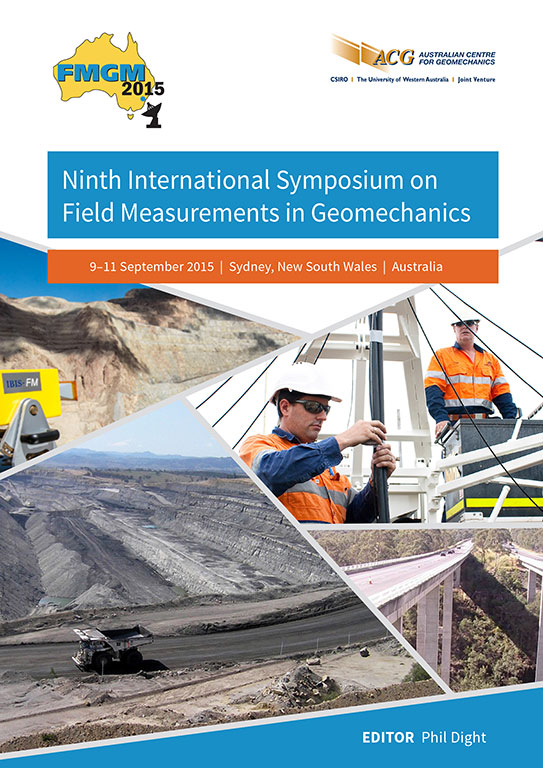Innovative InSAR approach to tackle strong nonlinear time lapse ground motion

|
Authors: García Robles, J; Mora, O; Salvá, B |
DOI https://doi.org/10.36487/ACG_rep/1508_15_Salva
Cite As:
García Robles, J, Mora, O & Salvá, B 2015, 'Innovative InSAR approach to tackle strong nonlinear time lapse ground motion', in PM Dight (ed.), FMGM 2015: Proceedings of the Ninth Symposium on Field Measurements in Geomechanics, Australian Centre for Geomechanics, Perth, pp. 261-274, https://doi.org/10.36487/ACG_rep/1508_15_Salva
Abstract:
Persistent scatter interferometry (PSI) based algorithms are the conventional tools used to aid in the detection of constant ground motion in a set of radar images within a concrete time span. Despite the fact that slight variations in the ground motion trend exist, the conventional linear PSI technique, used on a regular basis worldwide, is able to retrieve these variations incorporating its contribution to the general linear trend of the time series (TS). However, when the ground motion does not have linear dependence on time — for instance, in the case of different trends and even strong variations, such as the alternation of periods of heave and subsidence — the linear deformation model to differentiate/isolate the atmosphere is not applicable. This is because the linear method approach of decorrelation of atmosphere over time and its spatial correlation fails to comply. A new approach is therefore needed to be able to retrieve accurate measurements, irrespective of the motion being linear or nonlinear. With this new approach, a valuable, cost-effective technique to monitor motion either in civil engineering projects or in naturally occurring events with a nonlinear deformation pattern is provided. The objective of this paper is to present a new approach to the conventional methodology in order to tackle the nonlinearity problem, not only for the cases where it is not possible to apply the conventional PSI, but also for those that may benefit from the application of this new nonlinear methodology accuracy of the TS, despite the longer processing time. The methodology used to achieve this objective involves the use of conventional PSI algorithm techniques, combined with a nonlinear module which is based on the advanced differential Interferometric synthetic aperture radar (InSAR) technique with the aid of lineal-dependent models, such as error residual height (ERH) dependent on the spatial baseline of the satellite orbits and thermal compensation dependent on temperatures. In this paper, a comparison between both techniques in the same case study and with the same radar acquisitions is presented. The area chosen as a case study is a zone of the City of London, an area where nonlinear motion, triggered by tunnelling works, has been clearly discerned. Lineal processing was shown to possibly underestimate or misestimate the ground motion detected in the TS in a nonlinear scenario, while the new methodology was able to reflect when exactly the area under study was stable and when the period of motion started.
References:
Arnaud, A, Adam, N, Hanssen, R, Inglada, J, Duro, J, Closa, J & Eineder, M 2003, ‘ASAR ERS interferometric phase continuity’, Proceedings of the International Geoscience and Remote Sensing Symposium (IGARSS ’03), IEEE, vol. 2, pp. 1133-1335.
Berardino, P, Fornaro, G, Lanari, R & Sansosti, E 2002, ‘A new algorithm for surface deformation monitoring based on small baseline differential SAR interferograms’, IEEE Transactions on Geoscience and Remote Sensing, vol. 40, no. 11, pp. 2375-2383.
Blanco-Sánchez, P, Mallorquí, JJ, Duque, S, & Monells, D 2008, ‘The coherent pixels technique (CPT): an advanced DInSAR technique for nonlinear deformation monitoring’, Pure and Applied Geophysics, vol. 165, no. 6, pp. 1167-1193.
Ferretti, A, Prati, C & Rocca, F 2000, ‘Nonlinear subsidence rate estimation using permanent scatterers in differential SAR interferometry’, IEEE Transactions on Geoscience and Remote Sensing, vol. 38, no. 5, pp. 2202-2212.
Ferretti, A, Prati, C & Rocca, F 2001, ‘Permanent scatterers in SAR interferometry’, IEEE Transactions on Geoscience and Remote Sensing, vol. 39, no. 1, pp. 8-20.
Hanssen, RF 1998, Atmospheric heterogeneities in ERS tandem SAR interferometry. Delft University Press, Netherlands.
Mora, O, Mallorqui, J & Broquetas, A 2003, ‘Linear and nonlinear terrain deformation maps from a reduced set of interferometric SAR images’, IEEE Transactions on Geoscience and Remote Sensing, vol. 41, no. 10, pp. 2243-2253.
Thierry, P, Deverly, F, Reppelin, M, Simonetto, E, Lembezat, C, Arnaud, A, Raucoules, D, Closset, L & King, C 2005, ‘Survey of linear subsidence in an urban area using a 3D geological model and satellite Differential InSAR’, Proceedings of the Géoline Conference.
Usai, S 1997, ‘The use of man-made features for long time scale InSAR’, Proceedings of the International Geoscience and Remote Sensing Symposium (IGARSS ’97), IEEE, vol. 4, pp. 1542-1544.
Zebker, HA & Rosen, P 1997, ‘Atmospheric effects in interferometric synthetic aperture radar surface deformation and topographic maps’, Journal of Geophysical Research, vol. 102, no. B4, pp. 7547-7563.
© Copyright 2025, Australian Centre for Geomechanics (ACG), The University of Western Australia. All rights reserved.
View copyright/legal information
Please direct any queries or error reports to repository-acg@uwa.edu.au
View copyright/legal information
Please direct any queries or error reports to repository-acg@uwa.edu.au